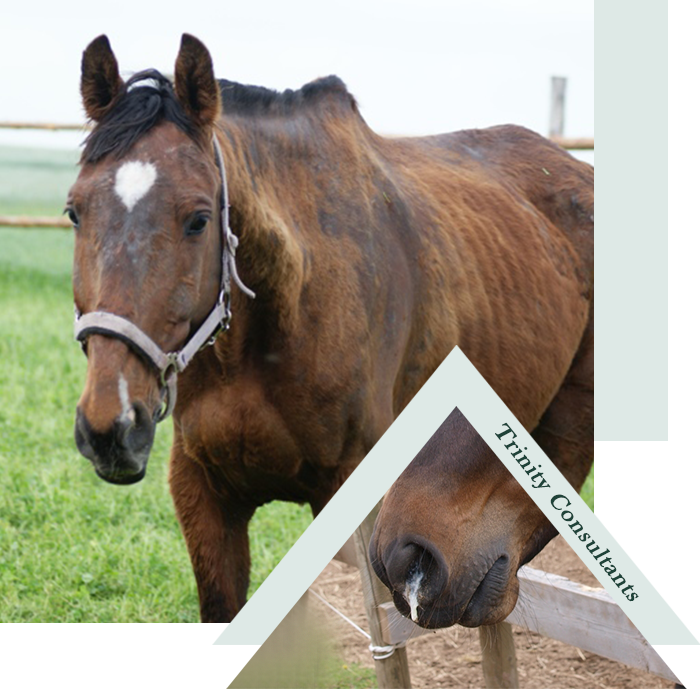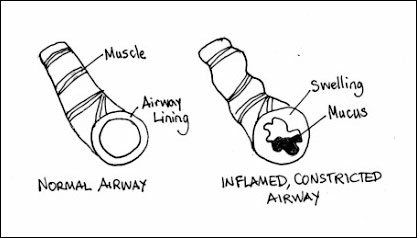COPD, also known as summer pasture-associated obstructive pulmonary disease (SPAOPD) and recurrent airway obstruction (RAO) or Heaves has been a problem for many years.
Symptoms of COPD
With Equine COPD, in most cases, inflammatory bronchiolitis results from a hypersensitivity reaction to inhaled allergens, as well as non-allergic airway overreaction to inhaled irritants and other substances such as endotoxins.
Horses commonly develop coughing, mucopurulent nasal discharge (especially when the head is lowered or after exercise) and increased expiratory effort (often with a double lift on expiration).
Often there is a history of ‘snot on the ground’ outside the stable door in the morning. These symptoms result from bronchospasm and accumulation of airway secretions, which also cause obstruction of the airways and often an increased respiratory rate.

Chronic Obstructive Pulmonary Disease or Heaves
It is on the extreme end of the respiratory allergy scale and is an allergic disease of the lung causing the small airways to constrict (get smaller in diameter) making it harder for the horse to breathe.
As a result, a horse may have a respiration rate of up to 36 or 40 breaths a minute – well above the usual 6 to 12 so causing the horse to breathe faster or deeper than usual and it may cough.
Many cases are very mild, and the signs may only be noticeable when the horse is exercised, but some cases can be very severe, causing permanent damage to the lungs.
COPD is also known as “Heaves” or Recurrent Airway Obstruction is a common condition affecting horses, ponies and donkeys of most breeds. Those under six years of age are rarely affected.

Causes of COPD
COPD in horses is caused by environmental problems such as dusty or mouldy hay, dust and moulds in bedding, or pollens, dust and other irritants in the environment.
When airborne allergens get down into the airways, they irritate the cells and cause mucus secretion, which will trigger a snort or cough. However, if the horse is allergic to one or more of these particle types, inhaling them will also cause inflammation.
Large numbers of white blood cells move into the area. Some of these cells secrete chemicals that cause swelling.
Others produce antibodies to the allergen(s) which causes even more inflammation. Because of the mucus and inflammation, less air can get through.
The smooth muscles in the walls of the lower airways constrict to prevent the allergens from passing further down into the lungs which reduce the amount of total air space in the airways and lungs.
Wheezing and coughing occur, which then worsen the irritation and inflammation in the lungs, causing a vicious circle in which the body’s own defences ultimately cause the most harm.
Horses Suffering from COPD
The lesions in the lungs of horses suffering from COPD are bronchiolitis with emphysema occurring in small areas. One of the major aims of treatment is to increase and or maintain adequate periphery circulation ensuring optimum blood flow to the lungs.
Why Equine Respiratory Health is Vital for Horse Owners and Veterinarians
Equine respiratory health is a critical aspect of overall wellness in horses. Conditions like COPD (Chronic Obstructive Pulmonary Disease) and asthma in horses, also known as equine asthma, significantly impact the health, performance, and quality of life of these animals. This article delves into the intricacies of equine asthma, its diagnosis, management, and treatment, providing invaluable insights for veterinarians and horse owners alike.
What is Equine Asthma?
Equine asthma, a term encompassing both mild and severe forms of chronic respiratory conditions in horses, includes diseases such as recurrent airway obstruction (RAO) and inflammatory airway disease (IAD). These conditions are characterized by airway inflammation, mucus production, and bronchoconstriction, which impede the horse’s ability to breathe.
Equine asthma typically presents as either mild asthma, which might cause occasional coughing and impaired performance, or severe asthma, which includes more pronounced symptoms like increased respiratory effort and chronic coughing. This disease is multifactorial and can be influenced by genetics, environment, and allergens.
Understanding COPD in Horses
Chronic Obstructive Pulmonary Disease (COPD) in horses, also known as heaves, is a severe form of equine asthma. COPD is primarily triggered by allergen exposure, such as hay dust, bedding, and airborne pollutants, leading to chronic inflammation and narrowing of the airways.
The condition in horses is similar to human COPD and requires long-term management. It often results in reduced performance and significant respiratory distress. Management of COPD involves environmental changes to reduce allergen exposure and medical treatments to control symptoms and prevent disease progression.
Recognising the Symptoms of Equine Asthma
Identifying equine asthma early can significantly improve outcomes. Common symptoms include:
- Chronic coughing
- Increased respiratory effort
- Nasal discharge
- Wheezing and crackles were heard during thoracic auscultation
- Impaired performance, especially during exercise
Environmental factors such as dust, pollen, and fungal spores often exacerbate these symptoms. A thorough history and physical examination by a vet are crucial for a presumptive diagnosis.
The Pathophysiology of Equine Asthma
The pathophysiology of equine asthma involves chronic inflammation of the lower airways, leading to mucus production and bronchoconstriction. This chronic inflammation results from an immune response to inhaled allergens, such as hay dust and mould spores.
In severe cases, the airway smooth muscle undergoes hypertrophy, further narrowing the airways and exacerbating respiratory difficulties. Understanding this process helps develop targeted treatment and management strategies to alleviate symptoms and improve the horse’s quality of life.
Diagnosing Equine Asthma: A Veterinarian’s Approach
Diagnosis of equine asthma typically involves a combination of clinical examination, history taking, and diagnostic tests. Key diagnostic tools include:
- Thoracic auscultation to detect abnormal lung sounds
- Endoscopy to visualize the airways
- Bronchoalveolar lavage (BAL) and tracheal wash to collect samples for cytology
- Radiographs to assess lung fields
These methods help identify the presence of inflammatory cells and mucus, confirming the diagnosis of equine asthma.
Treatment Options for Equine Asthma
Treating horses with equine asthma requires a multi-faceted approach. Treatment options include:
- Environmental Management: Reducing allergen exposure by using low-dust bedding, soaking hay in water, and improving stable ventilation.
- Medical Management: Bronchodilators are administered to relieve airway constriction, and corticosteroids are used to reduce inflammation. In severe cases, systemic corticosteroids and bronchodilators are used in conjunction.
- Regular Monitoring: Continuous assessment by a vet to adjust treatment plans as needed.
In severe cases of equine asthma, aggressive medical management is necessary to control symptoms and improve the horse’s breathing.
Environmental Management for Asthma in Horses
Environmental management is a cornerstone of treating equine asthma. Key strategies include:
- Low-dust bedding and feed are used to minimize airborne particles.
- Ensuring proper, stable ventilation to reduce the accumulation of dust and mold spores.
- Avoiding the storage of hay in areas where horses are stabled.
- Regularly clean and maintain stables to reduce allergen exposure.
These measures help to create a healthier environment for horses, reducing the frequency and severity of asthma flare-ups.
The Role of Medication in Managing Equine Asthma
Medications play a critical role in managing equine asthma. Common medications include:
- Bronchodilators: These drugs relax the airway’s smooth muscle, easing breathing.
- Corticosteroids: Both inhaled and systemic corticosteroids are effective in reducing airway inflammation.
- Mucolytics: Help reduce mucus production and improve airway clearance.
To ensure optimal management of the condition, these medications must be tailored to each horse’s specific needs under the guidance of a vet.
Preventing Asthma Flare-ups in Horses
Preventing flare-ups is crucial for managing equine asthma. Key preventive measures include:
- Regular environmental management practices.
- Minimizing exposure to known allergens, such as dust, pollen, and mould spores.
- Routine veterinary check-ups to monitor lung function and adjust treatment as necessary.
- Educating horse owners about maintaining a dust-free environment and proper stable management.
By implementing these preventive strategies, horse owners can significantly reduce the incidence of asthma exacerbations.
The Future of Equine Respiratory Disease Research
Research in equine respiratory diseases is continually evolving. Future directions include:
- Developing new medications and therapies to better manage and treat equine asthma.
- Investigating genetic predispositions to understand the hereditary aspects of the disease.
- Enhancing diagnostic techniques to enable earlier and more accurate detection of respiratory conditions.
- Exploring the role of environmental pollutants and their impact on equine respiratory health.
Ongoing research aims to improve the quality of life for horses suffering from respiratory diseases and provide better tools for veterinarians and horse owners to manage these conditions effectively.
Key Takeaways
- Equine asthma, including COPD and RAO, significantly affects horses’ respiratory health.
- Recognizing symptoms early and obtaining a proper diagnosis from a vet is crucial.
- Effective treatment involves a combination of environmental management and medical therapy.
- Preventive measures and regular monitoring can reduce the frequency of asthma flare-ups.
- Ongoing research is essential for advancing the understanding and management of equine respiratory diseases.
By understanding and addressing equine asthma, veterinarians and horse owners can work together to ensure the well-being and optimal performance of horses.
To help treat COPD or severe equine asthma, consider trying AH181 or preferably call 01243 551766 or email info@trinity-consultants.com first.
